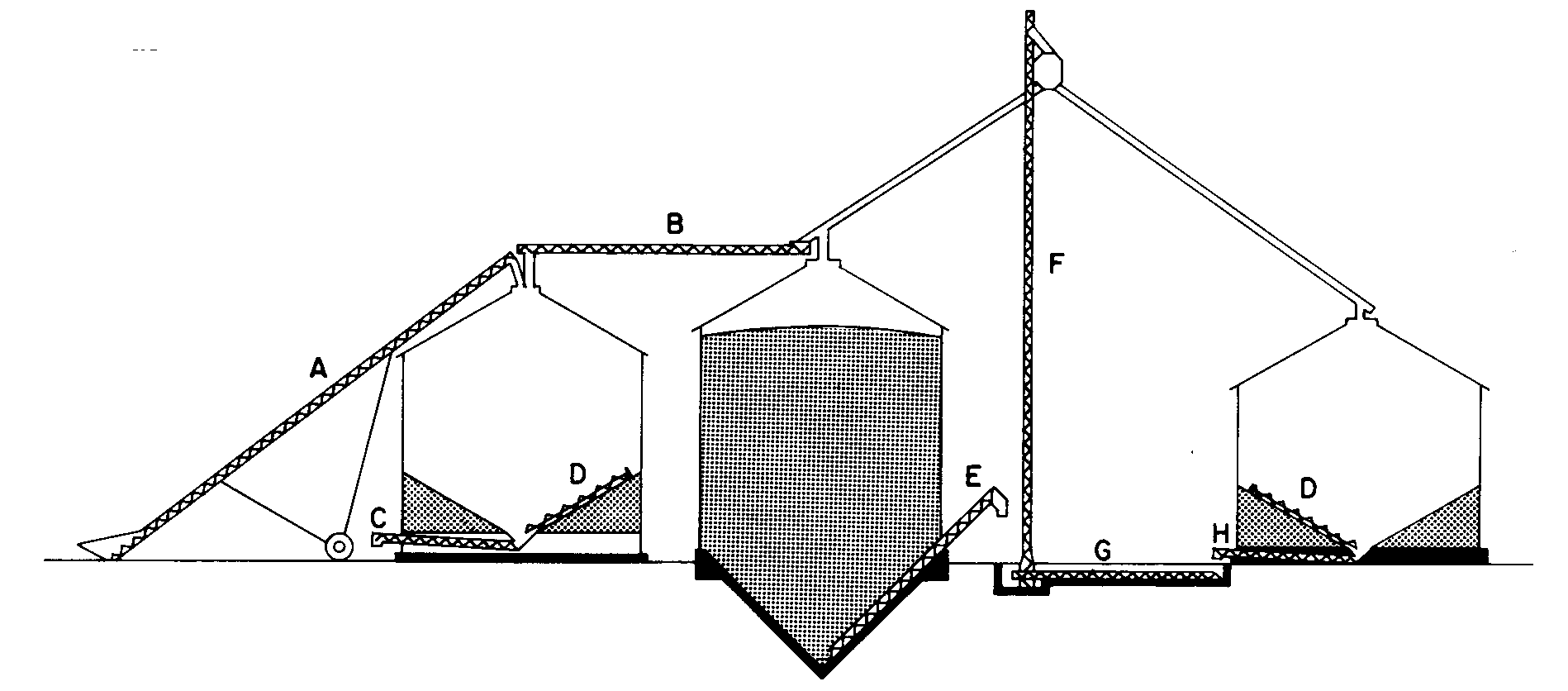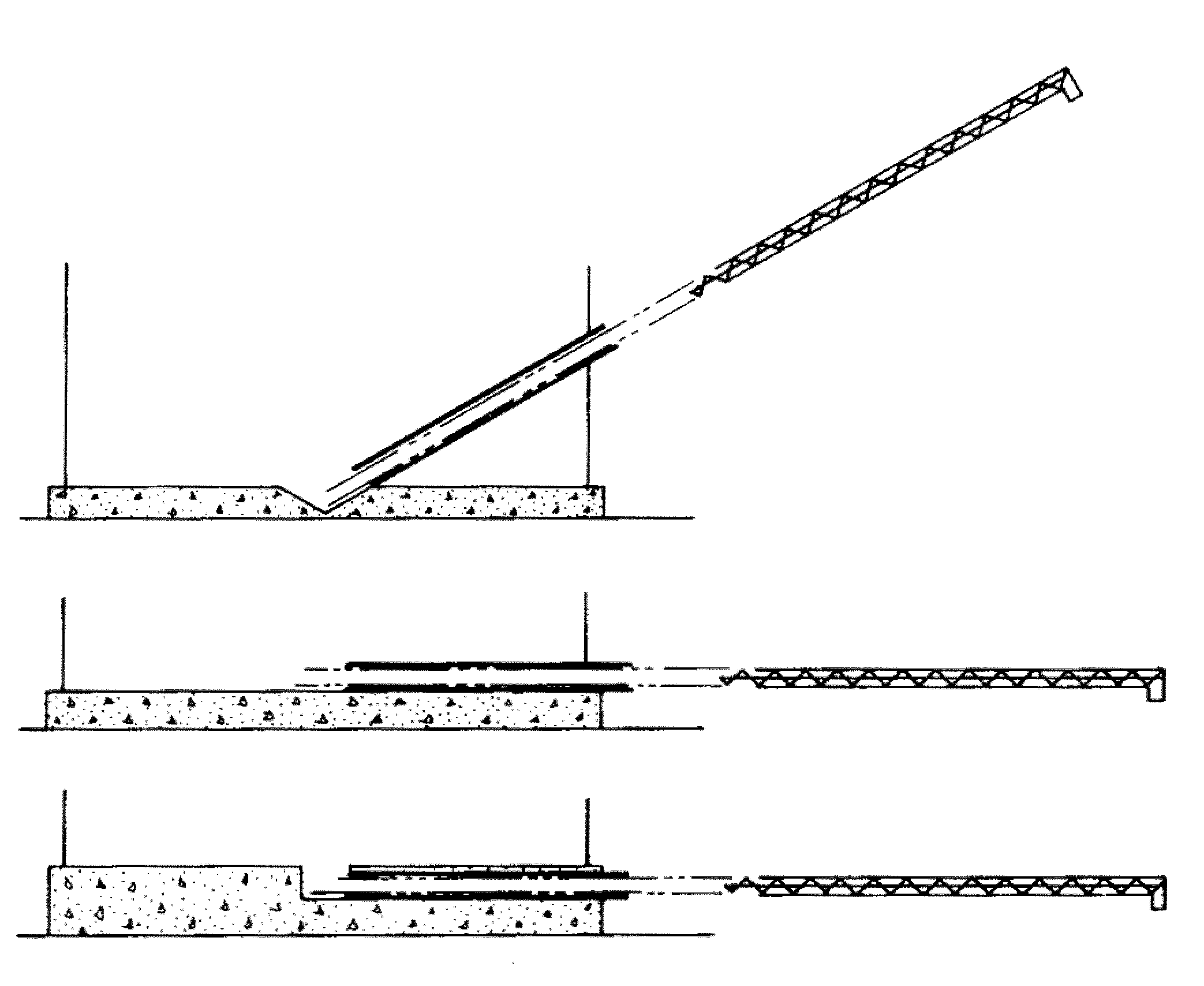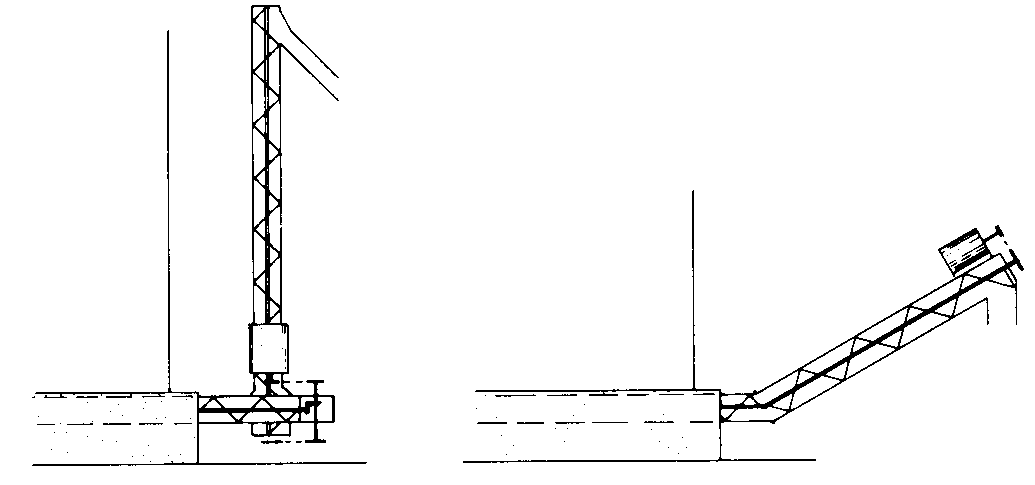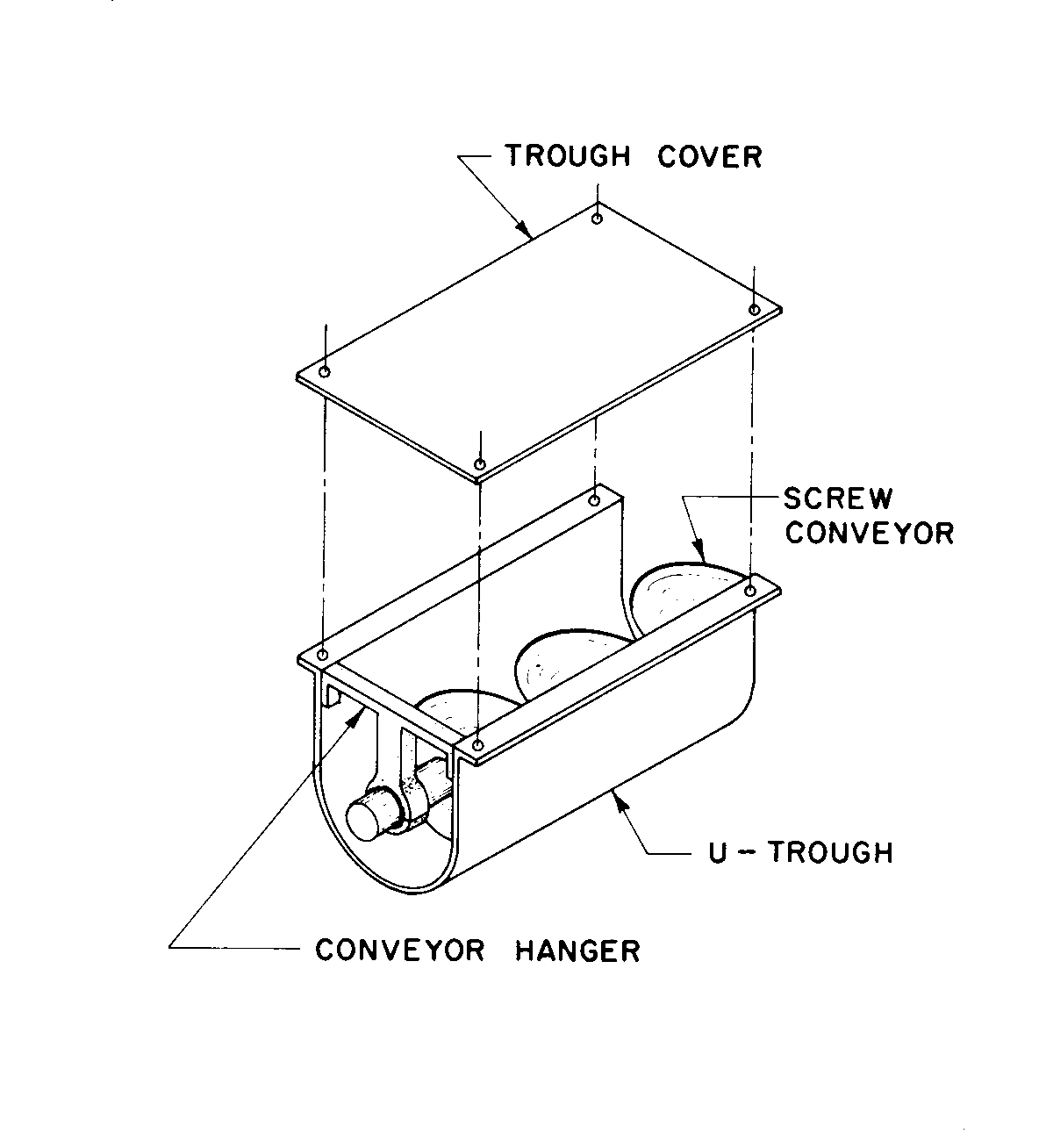Auger conveyors, sometimes called screw conveyors, are the most common method of handling grain and feed on farms. The purpose of this fact sheet is to describe various types and uses of augers. Capacities and power requirements are given to aid in planning and selection. Information is also given to aid in selecting motors and V-belt drives.
Augers are available in various types and sizes designed for different jobs, some of which are illustrated in Figure 1. Portable or transfer augers are available in 6-, 8-, and 10-inch diameters and lengths from 20 to 60 feet. They can be powered by PTO, electric motor, hydraulic motor, or gasoline engine. Mobility is the most important feature, and nearly all on-farm grain systems include a transport auger.
Bin unloading augers may be permanently set or moved from one bin to another. If a metal sleeve is placed in the bin foundation, or through the bin sidewall, the unloading auger can be inserted when needed, as shown in Figure 2.
Large bins, or bins which are filled more than once a year, should be served by permanently mounted unloading augers. Permanently mounted unloading augers may have inclined or vertical discharge sections as shown in Figure 3.
Vertical augers can be used as the central elevating mechanism in a grain or feed system. However, if the annual volume to be handled is more than 30 to 10,000 bushels, a bucket elevator should be used.
In certain applications, such as, dump pits or bulk bins, augers can become overloaded if the flighting is exposed to the weight of the grain. In these cases, auger covers or auger shields are used. Gates or baffles, half-pitch flighting, or auger sections with reduced size or tapered flighting may also be used.

- transport auger
- horizontal overhead auger
- unloading auger in plenum of drying bin
- sweep auger
- unloading auger for cone-bottom bin
- vertical auger
- drive-over dump auger
- unloading auger in bin foundation
Figure 1. Augers are available in various sizes and types for different conveying jobs.
 Figure 2. If a metal sleeve is placed in the bin foundation or sidewall, an unloading auger
can be inserted when needed, and one auger can serve several bins, of the same or
different sizes.
Figure 2. If a metal sleeve is placed in the bin foundation or sidewall, an unloading auger
can be inserted when needed, and one auger can serve several bins, of the same or
different sizes.
 A (left) B (right)
A (left) B (right)
Figure 3. Bin unloading augers with A) a vertical discharge section using a right-angle drive and B) an inclined discharge section using a universal joint.
Auger Pitch
Auger pitch refers to the distance between corresponding points on consecutive turns of the auger flighting or the distance the conveyed material moves with one revolution of the auger. Most augers are standard pitch with pitch approximately equal to the auger diameter.
Capacities and Power Requirements
The capacity of an auger is affected by: auger diameter, auger speed, length of intake exposure, angle of elevation, and kind and moisture content of grain conveyed.The length of the auger will affect the power requirement, but not the capacity.
Tables 1 and 2 present capacities and power rerequirements of standard pitch auger conveyors handling shelled corn. Horsepower is that required at the auger drive shaft. Power loss in the drive train is generally estimated at 10percent, to be added to the table values. Tables I and 2 may also be used for wheat, grain, sorghum, oats, barley, and rye, though conveying capacity will be somewhat less for some of these grains; particularly oats. The power requirements of Tables I and 2 may also be used for augers handling ground or cracked grain or concentrate feed rations. Multiplying bu/hr by 50 will give approximate auger capacity in lbs/hr. To use Tables 1 and 2 for soybeans, reduce capacity values by 25percent and increase power values by 40percent.
Several important rules are illustrated in Tables I and 2.
- As angle of elevation increases from 0degrees to 90degrees, auger capacity decreases.
- Power requirements increase with angle of elevation to 45degrees, then decrease as the auger goes to 90degrees.
- Auger capacity and power requirement increase with auger speed. Practical limits are 1,000 RPM for 4-inch augers and 800 RPM for 6-inch augers.
- Auger capacity and power requirement increases with intake exposure. At long exposures, the power requirement increases at a greater rate than capacity. Normal exposure for standard pitch augers is 2 to 3 times auger diameter.
- Auger length has no effect on auger capacity or the power requirement per foot of length. Auger lengths are limited, however, by the maximum torque that the auger shaft and coupling pins will carry. This length is usually 60 to 100 feet, unless the auger is of special design. For longer distances, augers can be cascaded, as shown in Figure 4.
- When handling wet grain, auger capacity is about 60 percent of the capacity in dry grain. Horizontal augers handling wet grain require several times the power required for dry grain. Augers inclined 45 degrees require about twice as much power for wet as for dry grain. The power requirement in vertical augers is the same for wet or dry grain.
|
|
|
|
|
Angle of Elevation |
|
|
|
|---|---|---|---|---|---|---|---|
|
Auger Speed RPM hp/10' |
Intake Exposure inches |
0° bu/hr hp/10' |
45° bu/hr hp/10' |
90° bu/hr |
|||
|
200 |
6 |
590 |
0.2 |
370 |
0.33 |
220 |
0.25 |
|
12 |
590 |
0.28 |
500 |
0.44 |
280 |
32 |
|
|
18 |
620 |
0.32 |
510 |
0.47 |
310 |
36 |
|
|
24 |
630 |
0.44 |
555 |
0.55 |
350 |
0.4 |
|
|
400 |
6 |
970 |
0.35 |
650 |
0.6 |
380 |
0.46 |
|
12 |
1090 |
0.56 |
850 |
0.88 |
520 |
70 |
|
|
18 |
1174 |
0.74 |
940 |
1.02 |
560 |
80 |
|
|
24 |
1190 |
0.97 |
1010 |
1.18 |
660 |
0.92 |
|
|
600 |
6 |
1210 |
0.49 |
820 |
0.82 |
490 |
0.64 |
|
12 |
1510 |
0.84 |
1160 |
1.28 |
740 |
1.05 |
|
|
18 |
1650 |
1.17 |
1270 |
1.52 |
800 |
1.23 |
|
|
24 |
1700 |
1.47 |
1444 |
1.8 |
720 |
1.4 |
|
|
800 |
6 |
1320 |
0.58 |
890 |
0.95 |
40 |
0.77 |
|
12 |
1760 |
1.07 |
1370 |
1.62 |
890 |
1.32 |
|
|
18 |
1990 |
1.57 |
1510 |
2.08 |
1000 |
1.64 |
|
|
24 |
2140 |
1.95 |
1740 |
2.39 |
1100 |
1.89 |
* Moisture content, 14.5 percent wet basis.
Source: Research Bulletin No. 740, Purdue University Agricultural Experiment Station.
|
Angle of Elevation |
|||||||
|---|---|---|---|---|---|---|---|
|
Auger Speed RPM |
Moisture content % wet basis |
0° bu/hr hp/10' |
45° bu/hr hp/10' |
90° bu/hr hp/10' |
|||
|
4-inch conveyor |
|||||||
|
200 |
14 |
150 |
0.12 |
120 |
0.15 |
60 |
0.11 |
|
400 |
14 |
290 |
0.29 |
220 |
0.29 |
130 |
0.25 |
|
700 |
14 |
470 |
0.43 |
350 |
0.52 |
220 |
0.41 |
|
1180 |
14 |
650 |
0.63 |
460 |
0.81 |
310 |
0.67 |
|
6-inch conveyor |
|||||||
|
200 |
14 |
590 |
0.3 |
500 |
0.5 |
280 |
0.4 |
|
25 |
370 |
1.4 |
280 |
1.3 |
160 |
0.4 |
|
|
400 |
14 |
1080 |
0.6 |
850 |
0.9 |
520 |
0.7 |
|
25 |
690 |
1.8 |
510 |
1.8 |
300 |
0.7 |
|
|
600 |
14 |
1500 |
0.9 |
1160 |
1.3 |
745 |
1.1 |
|
25 |
950 |
2.4 |
680 |
2.3 |
380 |
1.1 |
|
|
800 |
14 |
1760 |
1.1 |
1370 |
1.6 |
890 |
1.3 |
|
25 |
1100 |
2.8 |
770 |
2.8 |
470 |
1.6 |
|
|
8-inch conveyor |
|||||||
|
200 |
14 |
1050 |
0.5 |
900 |
0.9 |
490 |
0.7 |
|
25 |
670 |
3.5 |
510 |
2.3 |
280 |
0.7 |
|
|
400 |
14 |
1950 |
1.1 |
1530 |
1.6 |
940 |
1.4 |
|
25 |
1250 |
3.5 |
930 |
3.4 |
550 |
1.4 |
|
|
600 |
14 |
2700 |
1.6 |
2100 |
2.4 |
1500 |
2 |
|
25 |
1700 |
4.3 |
1220 |
4.2 |
680 |
2 |
|
|
10-inch conveyor |
|||||||
|
200 |
14 |
2000 |
1 |
1700 |
1.6 |
930 |
1.3 |
|
25 |
1250 |
4.6 |
950 |
4.2 |
525 |
1.3 |
|
|
400 |
14 |
3650 |
2 |
2850 |
3 |
1750 |
2.5 |
|
25 |
2300 |
6 |
1700 |
6 |
1000 |
2.5 |
* Table values may also be used for wheat, grain, sorghums, oats, barley, rye, ground grain and concentrate feed rations. Multiplying bu/hr by 50 will give the approximate lbs/hr capacity when conveying meal or concentrate feed rations. For soybeans, reduce capacity values by 25% and increase values by 40%.
Source: Research Bulletin No. 740, Purdue University Agricultural Experiment
 Figure 4. Augers may be cascaded over long distances.
Figure 4. Augers may be cascaded over long distances.
Selecting Augers
The quality of augers available for farm use varies greatly. Quality is usually reflected in useful life and reliability, though it may affect capacity as well.
Less expensive augers have bearings at the drive end only. When these augers are operated empty, wear is excessive as the flighting contacts the case.
More expensive augers have bearings at both ends and intermediate bearings along the shaft. They usually have heavier gauge flighting and casings. Some capacity is sacrificed due to intermediate bearing mounts, though this problem is reduced by using U-trough augers as illustrated in Figure 5.
Auger life and reliability are increased by selecting large diameter augers and U-troughs and operating them at low speed. Auger life and reliability are most important for augers which are difficult to repair or replace; such as, overhead augers or augers in dump pits.
 Figure 5. U-trough conveyors have the advantages of being fully bearing-mounted, easily loaded
at any point along the conveyor, easily repaired, and give longer service life.
Figure 5. U-trough conveyors have the advantages of being fully bearing-mounted, easily loaded
at any point along the conveyor, easily repaired, and give longer service life.
Selecting Motors and Drives
Tables 1 and 2 can be used to determine the power requirements for augers. The table values must be multiplied for auger length and then increased by 10percent for drive-train power loss. If the auger will handle wet grain, be sure to use the wet grain power requirement.
Table 3 may be used to select motors based on calculated auger Hp and continuous operation. When electric motors must be mounted in positions other than horizontal, they should be equipped with thrust bearings.
Electric motors over1/2 Hp should be operated on 230 volts, controlled by a motor-starting switch, and have the grounded neutral wire attached to the motor frame for shock protection. Properly sized overcurrent protection must be used. If an ordinary on-off switch is used, install time-delay fusetrons or fusestats sized to 115percent of the name-plate operating current.
Fractional horsepower (FHP) V-belt drives are frequently used with grain augers. Larger motors require multiple V-belt drives.
Table 4 is presented as a guide for selecting pulleys for V-belt drives powered by 1750 RPM electric motors. The speed ratio is the ratio of motor RPM to the desired auger RPM. This, then, is the desired ratio of auger pulley diameter to motor pulley diameter. When the motor pulley diameter has been selected, it may be multiplied by this ratio to determine the required auger pulley diameter. Several pulley combinations are given in Table 4 as examples.
V-belt drives are limited in the Hp that can be carried per belt. This value is determined by the type, size, and length of belt; the speed and size of the small pulley; and the ratio of pulley diameters, which determines the belt contact length on the small pulley. Small diameter pulleys should be avoided for this reason. For electric motors up to 3 Hp, the minimum recommended pulley outside diameter is 2 1/2 in.
Safety Considerations
Augers can represent one of the greatest safety hazards on farms. All exposed auger drive assemblies should have safety shields. All auger intakes should be covered by a grate designed to keep hands, feet,and clothing from contacting the auger flighting or being caught between the flighting and case. The grate should easily support the weight of a man.
A deadly hazard exists for anyone in a grain bin when the unloading auger is started. Deaths occur annually from suffocation and injuries inflicted by the unloading auger in this situation. Many of these victims are children.
Disconnect power to the unloading auger before entering the bin, or place an on-off switch at the point where the bill is entered, or use a power lockout switch. A knotted safety rope hanging near the center of the bin offers some protection. A second person standing by can offer assistance and summon aid.
An air pocket sometimes forms when grain bridges over unloading augers due to spoiled grain or moisture accumulation. Never walk on the grain surface if this occurs. One can be trapped when the pocket collapses. Break up the pocket by using a long pole from outside the bin.
Wear an effective dust mask when exposed to grain dust. In particular, avoid breathing mold dust from spoiled grain.
When children are present on the farm, never engage any machinery before checking on the possible presence of a child.
|
Calculated Conveyor Hp. |
Electric Motor Size, Hp |
Gasoline Engine Size, Hp |
|---|---|---|
|
Up to .27 |
1/4 |
1/2 |
|
28 to 35 |
1/3 |
2/3 |
|
36 to 55 |
1/2 |
1 |
|
.56 to .81 |
3/4 |
1 1/2 |
|
.82 to 1.10 |
1 |
2 |
|
1.11 to 1 60 |
1 1/2 |
3 |
|
1.61 to 2.10 |
2 |
4 |
|
2A 1 to 3.20 |
3 |
5 |
|
3.21 to 5.25 |
5 |
8 |
Values from Tables I and 2 multiplied for auger length and increased l0percent for drive train power loss.
|
Desired Auger Speed RPM |
Required Ratio, * Auger Pulley Dia. Motor Pulley Dia |
Motor Pulley Pitch Dia. (in.) |
Auger Pulley Pitch Dia. (in.) |
Actual Auger Speed (RPM) |
|---|---|---|---|---|
|
200 |
8.75 |
2 |
17.5 |
200 |
|
2.2 |
19 |
203 |
||
|
300 |
5.83 |
2.2 |
13 |
296 |
|
3.2 |
18.5 |
303 |
||
|
400 |
4.38 |
2.4 |
10 5 |
400 |
|
3.6 |
16 |
394 |
||
|
500 |
3.5 |
2.3 |
8 |
503 |
|
3.6 |
12.5 |
504 |
||
|
600 |
2.92 |
2.4 |
7 |
600 |
|
3.6 |
10.5 |
600 |
||
|
700 |
2.5 |
2.2 |
5.5 |
700 |
|
3.2 |
8 0 |
700 |
||
|
3.4 |
8 5 |
700 |
||
|
800 |
2.19 |
2.4 |
5.2 |
808 |
|
3.6 |
8 |
788 |
||
|
900 |
1.94 |
2.3 |
4.5 |
894 |
|
3.6 |
7 |
900 |
||
|
1000 |
1.75 |
2.8 |
5 |
980 |
|
3.2 |
5.5 |
1018 |
||
|
4 |
7 |
1000 |
Calculated as motor RPM ÷ desired auger RPM, the speed ratio.
Pete Bloome
Extension Agricultural Engineer
Sam Harp
Manager, OSU Farm Building Information Service
Gerald Brusewitz
Associate Professor, Agricultural Engineering
